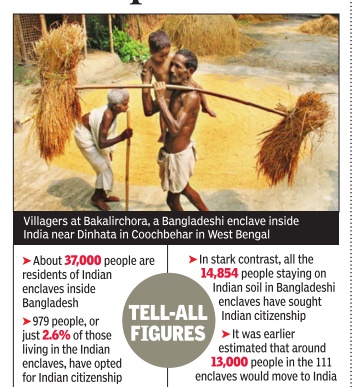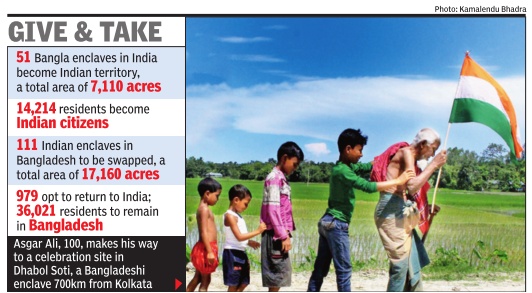India- Bangladesh enclaves
This is a collection of articles archived for the excellence of their content. |
How the enclaves were formed
The Times of IndiaJun 01 2015
Jayanta Gupta & Pinak Priya Bhattacharya
These enclaves were part of the former Cooch Behar kingdom, which ceded pockets of territory to the Mughals and the British. When Cooch Behar acceded to India, parts of it which were in Bangladesh (then East Pakistan), naturally became part of India, except for the small technicality of them lying in another country . For decades, residents of the enclaves have lived in isolation in a sense: A Bangladeshi enclave, surrounded by India, is cut off from facilities and benefits from its own country . The same happens to Indians marooned in Bangladeshi territory . The constitutional amendment essentially allows the countries to swap land so that those living in the enclaves can get citizenship rights without having to move out of their traditional homes if they do not wish to. It will also settle the decades-old border disorder.
Low turnout for Indian citizenship in enclaves

The Times of India, Jul 25 2015
Debasish Konar
Jamaat role seen as just 979 from enclaves opt for India
Not many yes for Indian citizenship from the 37,000-odd people staying in Indian enclaves inside Bangladesh has raised the suspicion of a Jamaat-e-Islami hand in ensuring a very low turnout. Just 979 people, or about 2.6% of those living in the Indian enclaves, have opted for Indian citizenship. In stark contrast, all the 14,854 staying on Indian soil in Bangladeshi enclaves have sought Indian citizenship. A home department official said there were allegations that Jamaat had prevented Indian enclave-dwellers from freely exercising their option. The home ministry has been alerted on this, he added.
The numbers have even surprised officials as the Centre has assured a kitty of Rs 3,000 crore for rehabilitation of the people who shift from the Indian enclaves in Bangladesh. It was earlier estimated that around 13,000 people in the 111 enclaves would move to India.
Cooch Behar Trinamool Congress MP Renuka Sinha confirmed the development.She said several thousand Indians living in Indian enclaves in Bangladesh had not been able to express their option freely as they had been intimidated by Jamaat activists. “I have written to Union home minister Rajnath Singh and external affairs minister Sushma Swaraj. Those who wanted to opt for India were not allowed to do so. Jamaat activists put their thumb impressions on the option papers and stated Bangladesh as their choice,“ she alleged. Many enclave-dwellers working in different parts of India have complained to the district magistrate of Cooch Behar to make their option as they were intimidated, said Debabrata Chaki of the Indian Enclaves United Council. He said even people with land deeds were prohibited from exercising their option.
2015: Freedom from uncertain belongingness
The Times of India, Aug 01 2015

Saibal Sen & Pinak Priya Bhattacharya
Moshaldanga (West Bengal)
Bangladesh, India in historic enclave swap
At the stroke of midnight, 14,214 citizens of Bangladesh, who had been residing in 51 enclaves within India, became Indians. It's an independence that has come late, but arrived nonetheless. The tricolour was unfurled in these enclaves, at half-mast because India is mourning former President APJ Abdul Ka lam. At the same time, 111 Indian enclaves in Bangladesh merged with that country . Of the 37,000 living there, 979 have opted to move to India, allaying fears of a huge transfer of population when the historic Land Boundary Agreement became operative and both countries redrew their boundary maps along north Bengal.No one from the Bangladeshi enclaves in India has chosen to cross over. The total number of new Indian citizens will be 15,193. The swap will be completed by November 2015.